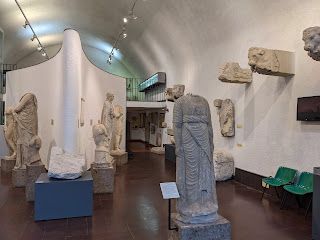Left: Example of abbreviation HMHNS on Roman tombstone (100 - 0 BC). Grassobbio, villa Colombiani.
Center left: Example of abbreviation TFI on Roman tombstone (100 - 200 AD). Bariano.
Center: Example of abbreviation TFIS on Roman tombstone (100 - 200 AD). Bolgare.
Center right: Example of abbreviation VSLM on Roman tombstone 100 - 200 AD). Martinengo.
Right: Mosaico di Calcio (200-300).
Do you draw a blank when staring a Roman inscription on a monument such as the one pictured above and feel embarrassed that you can’t figure it out? We do. Don’t feel bad because it’s not easy and there is a profession whose job it is to know this. They are called epigraphers and the field is called epigraphy. Epigraphy is the study of inscriptions, or epigraphs.
Recently, we were visiting the Civico Museo Archeologico of Bergamo and came across some Roman funerary stelae. That subtle feeling of stupidity came over us as we stared at the Roman square capital letters but no meaning came from them. Fortunately, the information placards in the museum were super helpful in the interpretation and taught us a few tricks.
One of the tricks we learned reading Roman funerary inscriptions is how to interpret some commonly used abbreviations. An abbreviation is a series of letters acting as a shortcut – a formula – for representing a sentence or complete idea. For example, one of the most common that you might have seen is SPQR an acronym of the Latin phrase Senātus Populusque Rōmānus meaning “The Roman Senate and People”.
Here are a few abbreviations that we learned about today at the Bergamo Archeological Museum:
TFI
- Latin: testamento fieri iussit
- Description: The funeral monument was made after the person died, usually by heirs to whom the deceased donated money to build the monument.
- Our take: This tomb not a fake!?
TFIS
- Latin: testamento fieri iussit sibi
- Description: Like above, but with emphasis that deceased ordered this done for himself.
- Latin: votum solvit libens merito
- Description: The deceased fulfilled his/her vow gladly, willingly, e.g., to a deity.
- Latin: hoc monumentum heredem non sequetur
- Description: The monument is not to go to the deceased’s heirs; this monument is not part of the inheritance.
- Our take: There were feuding families back then too!?
- Latin: vivus (sibi) fecit
- Description: The deceased prepared this monument in his/her lifetime for his/her family, generally when one of his/her relatives died.
- Latin: dis manibus
- Description: Renders the burial place sacred, protected from profanity by the gods; sort of like in the hands of god.
- Our take: Good luck with that.
The Archeological Museum of Bergamo is tucked away in one corner of the Cittadella. The nearby Natural History museum draws a greater number of visitors but if you want to get glimpse of the history of Bergamo from the Neolithic to the Iron Age, from the Golasecca culture to the Romans, then this museum is the place to go.




Left: "Ancient Pelabrocco" spoon. Date unknown.
Center left: Perhaps a portrait of bust of Bergimus - god of Celtic origin (300 - 100 BC).
Center right: Brembate Sotto Anthropoid hilt (500 BC - 100 AD).
Right: Table showing correspondence between Greek, Phoenician, Etruscan and Latin letters.








No comments:
Post a Comment
All comments are moderated. If your comment doesn't appear right away, it was likely accepted. Check back in a day if you asked a question.